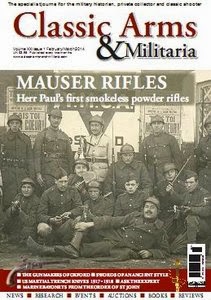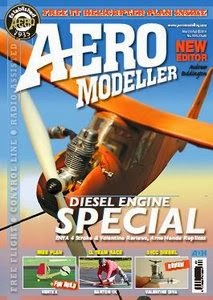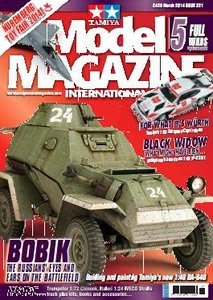Monday, February 24, 2014
Classic Arms & Militaria 02-03/2014
The widespread adoption of firearms which used metallic cased cartridges from about 1870 onwards created a requirement for inert cartridges to teach the soldier how to manipulate his weapon. This became increasingly important with die advent of magazine rifles. The only way that an instructor could be sure that his pupils had assimilated the lesson was to see them conduct a successful loading and firing cycle with inert ammunition. During the muzzle-loading era, the lack of dummy ammunition was not an issue. Loading drill could be conducted without it and lightly charged blank or "blunt" cartridges could be used when necessary to give the soldier a better impression of his firearm's function. As firearms grew more technically complex, armourers and other artificers needed inert ammunition to check functionality and wear. Consequently, a new type of inert ammunition the Drill or Dummy cartridge began to appear. In 1871 die famous Scottish gunmaker Alexander Henry advocated a dummy cartridge for use in the .577 Snider rifle. The main part of the case and the tapered "bullet" were made from turned boxwood. The head was brass and the "primer" was an India-rubber plug designed to absorb die impact of the striker. Mr Henry patented his design (No. 3257/1870) and promoted it vigorously amongst die Volunteer Movement. He claimed that soldiers could "..make constant HOME PRACTICE without danger, expense or injury to the rifle and the manipulation is a perfect as though using live cartridges". Henry's dummy cartridges cost 2 shillings and 6 pence for 10 or 100 might be had for a guinea including rail delivery. Specimens are rare today.
Classic Arms & Militaria 01/2014
Early firearms were invariably smooth-bore weapons because, initially, no one understood that putting grooves in the barrel of a gun to make the ball spin would increase its accuracy Even after this discovery was made, a rifled barrel was not very easy to make by hand and it was not until the beginning of the 16th century that rifled weapons began to appear regularly in Europe. These first rifles were of either Austrian or German manufacture and although they were accurate and popular with the sporting shooter, they never gained general acceptance by the military. The problem was loading. If the designer increased the size of the ball so that it was a tight fit in the bore, forcing the ball down the barrel past the rifling made it difficult to load and, if the ball was looser, the accuracy of the weapon was reduced to barely that of an equivalent musket. Very-early rifle shooters used a wooden mallet to knock the ball down the rifling, but this was not totally-satisfactory and rifles did not become really popular until their loading problems were partially overcome by the development of a process called 'patch-loading'. This involved the use of a patch of paper, cloth or even leather which was wrapped around the ball before it was inserted into the barrel and forced down to seat on to the charge. The patch gripped the grooves in the barrel sufficiently to impart the required spin to the ball and so rendered the rifling effective.
Aero Modeller March/April 2014
One of the special appeals of competition free-flight is that it's a purely objective sport, with simply a stopwatch to decide the result, rather than the subjective opinion of some judge. It's also a man (or woman) versus the elements. You, the flyer, will have pre-adjustcd several factors on the model that determine the flight (CG position, tailplane incidence for power or tow and for glide, rudder setting, differential wing incidence, propeller variable pitch changes,) and several of these maybe timer-controlled in flight. But in the end it is you who decides when to launch and that is when the elements bit comes into play. That model is going to end up somewhere downwind and you're going to need it back for several more rounds. Deciding when to launch usually means judging the air (temperature, wind speed and direction,) with the aim of finding a thermal to boost the flight performance to provide a max. When the model DTs (you did start the timer or set the fuse...?) is when the first stage of the retrieval phase begins. However, there's a lot you can do long before you get to the flying field that will help you to go home with the same number of models you set out with.
Aviation News 03/2014
With the successful conclusion of Operation Corporate, the campaign to retake the Falkland Islands from Argentina in 1982, the RAF found itself faced with supporting a large UK military presence 8,500 miles (13,680km) from home. It had no strategic transport aircraft and its air-to-air refuelling (AAR) tanker fleet was, inevitably, going to be overstretched. An ongoing programme of Vickers VC10 tanker conversions would help, but much of the life of its existing Handley Page Victor tankers had been consumed during Corporate. The RAF therefore had an urgent requirement for a large tanker/transport and British Airways (BA) was identified as having a suitable aircraft available. Six long-range Lockheed L-1011 TriStar 500 trijets had been ordered in August 1976, with the first placed in service during January 1979 and the last in May 1981. The new aircraft performed admirably on the carrier's long, thin routes (long haul, with passenger volumes insufficient for cost-effective service with larger aircraft), but proved somewhat costly to operate. Struggling to raise cash during a period of recession, BA took the opportunity to sell its nearly-new TriStar 500 fleet to the RAF. A deal was struck later in 1982 and a period of transition followed. The first to be transferred, G-BFCF was withdrawn from commercial service in December and by the following March all six had ceased scheduled flying. However three made temporary returns to BA service.
Airforces Monthly 03/2014
DURING A visit to the Dassault Rafale combat aircraft final assembly line at Bordeaux-Mérignac on January 10 Jean-Yves le Drian, France's Minister for Defence, awarded a contract to Dassault for development of the F3R standard Rafale from France's defence procurement agency, the Direction Générale de l'Armement (DGA- General Directorate for Armament). The F3R is a further evolution of the Rafale F3 standard and will enable Dassault to integrate the European Meteor long-range air-to-air missile produced by MBDA, the Thaies PDL-NG new-generation laser designator pod and HAMMER (Highly Agile Modular Munition Extended Range), the laser homing version of the Sagem AASM (Armement Air-Sol Modulaire or Modular Air-to-Ground Weapon) that was partially integrated as an urgent operational requirement for France's Operation Serval in Mali. The DGA plans to buy 20 PDL-NG pods, of which 16 will be delivered between 2018 and 2019. The F3R will also include upgrades to Rafale's sensors and systems. Validation of the F3R standard is scheduled for 2018.
Aeroplane Magazine 04/2014
Following a two-year restoration in Cosford's Michael Beetham Conservation Centre, Britain's only surviving Hawker Siddeley Kestrel was unveiled in the Research and Development Hangar at the RAF Museum Cosford on January 24, just short of 50 years after the first flight of the type. The historic machine, XS695, is the only Kestrel ever to go on display in the country of its birth. Not only is XS695 an important addition to the RAF Museum collection, but it now provides Britain with the only major "link" in the Hawker Harrier V/STOL story not previously represented in the UK-wide museum system, completing the story of what is arguably the most innovative combat aircraft ever developed in Britain, three years after the last Harriers were retired from RAF service. Britain's last remaining Kestrel was the eighth of nine Kestrel FGA.l development aircraft, making its first flight from Dunsfold on February 19, 1965, with Hawker test-pilot Duncan Simpson at the controls. After almost 6hr of test flights, on March 30, 1965, XS695 was delivered to the Tripartite (Anglo-American-German) Kestrel Evaluation Sqn, at West Raynham. The unit had been set up to evaluate vertical take-off aircraft in simulated sen-ice conditions.
Tamiya Model Magazine International 03/2014
In 1960, Boeing bought Vertol Aircraft Co., a helicopter manufacturer in Philadelphia, Pa. The company had three tandem-rotor helicopters in production: the Chinook for the Army, the Sea Knight for the Navy and the Marines and the commercial 107-11 for the airlines. Chinooks first were used in combat in 1965 during the Vietnam conflict. By 1968, the Chinook had put in 161,000 hours of flying time, carrying 22.4 million passengers and more than 1.3 million tons of cargo. During the last days of the war, one Chinook is reported to have carried 147 refugees in a single lift. CH-47A, B and C models served with distinction for a decade until the war's end in 1975. During 2002, Boeing was developing the CH-47F, scheduled for first production in 2004 and was under contract to modernize at least 300 Chinooks to the new F-model standard, which featured reduced vibration, an integrated cockpit control system and more powerful engines with digital fuel controls. These improvements would make the Chinook fully compatible with 21st century operational and war-fighting requirements and improve the aircraft's efficiency and effectiveness. (From Boeing's website). The CH-47 as represented in the Trumpeter box is a machine assigned to the US Army Aviation Test Board at Fort Rucker, Alabama. This helicopter was used for logistics evaluations.
Military Illustrated Modeller 03/2014
The Avia S199 was a propeller-driven fighter aircraft built after World War II by the two aircraft factories in Czechoslovakia. Avia continued building the Messerschmitt Bf 109 G-6 after the war under the Avia S-99 name, but soon ran out of the 109's Daimler-Benz DB 605 engine after many were destroyed during cn explosion at a warehouse in Krâsné Brezno. The S-199 continued to use the Bf 109 G airframe but, with none of the original engines available, an alternative engine had to be used. It was decided that as a replacement for the original engine, the aircraft would use the same Junkers Jumo 211 F engine and propeller as the Heinkel He 111 bomber. The resulting combination of parts was an aircraft with extremely poor handling qualities. The substitute engine with the propeller locked the responsiveness of the Daimler-Benz unit and the torque created by the massive paddle-bladed propeller made control very difficult. This, in combination with the 109's narrow-track undercarriage, made landings and take-offs extremely hazardous. The Daimler-Benz DB 605 engine allowed for a centrally mounted cannon that fired through the propeller spinner. This was not possible with the Junkers Jumo 211, so the S-199 used a version of the Luftwaffe's Rüstsatz VI modification kit, which consisted of a pair of MG 151 cannon, one each in a gun pod, one beneath each wing. This further impaired the aircraft's performance. A final hidden danger lay in the gun synchroniser for the cowl-mounted MG 131 machine guns that did not work as it was meant to, leading a few Israeli aircraft to shoot off their own propellers.
America In WWII 04/2014
It was New Year's Day 1945. Allied armies were marching toward Germany. Japan was getting pushed back toward its home islands. Americans were beginning to see light at the end of a long, dark tunnel of war. As they ate pork and sauerkraut, listened to the Rose Bowl on the radio, and daydreamed about their boys coming home, they probably weren't thinking about the trouble with horse racing. But they weren't James F. Byrnes. James F. Byrnes, the director of the US Office of War Mobilization, worried about the manpower and resources that racing consumed. Thousands of able-bodied workers kept stables and tracks operating. Fans wore tons of rubber off their tires and burned untold gallons of gasoline getting to tracks to toss money away on bets. Byrnes had long wanted to shut the sport down. On January 3, 1945, he did. Horse racing was banned—the only sport the government prohibited during the war. Byrnes had to overcome powerful interests to enact his ban. There was an awful lot of money in thoroughbred racing. Americans pulling high salaries from lucrative wartime jobs had money to spare. Gambling, which then usually meant horse racing, offered excitement and the chance to multiply earnings in an instant.
Jets Magazine March/April 2014
As we sit having lunch in the RAF Club in London's Piccadilly I immediately notice something about the cheery Rick Peacock-Edwards... he uses the word 'interesting' a lot. Flying Lightnings on border patrols in Germany during the Cold War was 'interesting'; being stationed at Dhahran in Saudi Arabia during the build-up to the first Gulf War made for 'a very interesting time' - as was transiting four Tornados to Oman one night over a very stormy Mediterranean. While he may play down many of his somewhat hair-raising experiences with a wry chuckle, Rick is swift to emphasise the pleasure flying brings him,"I've loved every single flying hour I've ever done. And I'm pleased to say, I haven't had to jump out of an aircraft!" He's also embarked on a post-RAF career to 'give something back'. The son of a Battle of Britain pilot, Rick was educated in South Africa from where he joined the RAF in 1965. He spent over 30 years in the RAF and retired as an Air Commodore in 1999 with a number of achievements under his belt, including Station Commander at RAF Leeming, Deputy Commander RAF Staff Washington, Inspector of Flight Safety and Director of Eurofighter His flying career has been spent mainly on fighters and he has over 1,000 hours on each of the Lightning, Phantom and Tornado. He also has over 1,000 hours on the Gnat and has flown many other types including the Hawk and Hunter.
Classic Military Vehicle 03/2014
From the early twenties until the mid- to late thirties, the standard fare of the Royal Tank Corps was the Vickers Medium Mk II supported by various marks of light tank. The Medium Mk ll's projected replacement - logically enough to be known as the Medium Mk III - fell victim to the financial cutbacks of the thirties and did not get beyond the prototype stage. Sir John Carden of Vickers-Armstrong, the company behind the Medium Mk III, then designed a cheaper alternative designated the A9, which incorporated some of the improvements of the Medium Mk III but was lighter and powered by an existing, readily available engine. First choice was to have been the 7.67-litre Rolls-Royce Phantom II, but that proved not to have the required power, so AEC's 9.64-litre A179 bus engine was selected instead. Two different types of main armament were initially proposed, a three-pounder and a3.7in howitzer. Trials commenced in July 1936 and production started in 1937, by which time the proposed three-pounder had been supplanted by a two-pounder which in the meantime had become the new standard tank gun. Of more long-term importance was the War Office's decision to dispense with the old medium class of tanks and to instead divide requirements into three classes, light, cruiser and infantry. Accordingly, the A9, which would have preciously fallen into the medium class, became the Cruiser, Tank, Mk I (A9) or Mk I CS (A9) in the case of the howitzer-armed close-support variant.
Subscribe to:
Comments (Atom)










